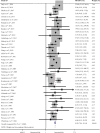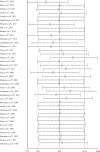Risk of type 2 diabetes mellitus after gestational diabetes mellitus: A systematic review & meta-analysis
- PMID: 34782531
- PMCID: PMC8715678
- DOI: 10.4103/ijmr.IJMR_852_18
Risk of type 2 diabetes mellitus after gestational diabetes mellitus: A systematic review & meta-analysis
Abstract
Background &objectives: Women with gestational diabetes are at an increased risk of being diagnosed as type 2 diabetes, but the postpartum screening rate is low. To provide evidence-based data for health providers and promote postpartum screening, this systematic review and meta-analysis was conducted to access the risks of type 2 diabetes mellitus (T2DM) diagnosis after gestational diabetes mellitus (GDM) in different demographic and maternal subgroups.
Methods: MEDLINE, Embase and Cochrane Library were searched systematically. Unadjusted relative risks (RRs) and 95 per cent confidence intervals (CIs) were calculated and pooled using a random-effects model. Heterogeneity was assessed with Cochrane's Q text and by calculating I2 values. Subgroup analyses were conducted to address the disparities of type 2 diabetes conversion after gestational diabetes in different demographic and maternal subgroups.
Results: 1809 publications were screened and 39 cohort studies including 2,847,596 women were selected. In these studies, 78,893 women were diagnosed as T2DM at six weeks or later after delivery. The unadjusted RRs of women diagnosed T2DM at six weeks or later after delivery ranged from 1.32 (95% CI, 0.46-3.37) to 47.25 (95% CI, 2.95-758.01) with a pooled unadjusted RR of 8.92 (95% CI, 7.84-10.14). Older women, women with a family history of diabetes, Black and non-Hispanic White women and women living in Europe and South-East Asia had a higher risk of developing T2DM after GDM.
Interpretation & conclusions: It is suggested that healthcare providers may focus on older women with GDM and women with GDM and a family history of diabetes. Black and non-Hispanic White women with GDM may receive more attention, and healthcare providers, especially those in Europe and South-East Asia, may pay more attention to preventive measures for postpartum T2DM.
Keywords: Blood glucose; OGTT screening; gestational diabetes mellitus; postpartum; type 2 diabetes mellitus.
Conflict of interest statement
None
Figures







References
-
- Cho NH, Shaw JE, Karuranga S, Huang Y, da Rocha Fernandes JD, Ohlrogge AW, Malanda B. IDF Diabetes Atlas:Global estimates of diabetes prevalence for 2017 and projections for 2045. Diabetes Res Clin Pract. 2018;138:271–81. - PubMed
-
- Kim C, Newton KM, Knopp RH. Gestational diabetes and the incidence of type 2 diabetes:a systematic review. Diabetes Care. 2002;25:1862–8. - PubMed
-
- Cormier H, Vigneault J, Garneau V, Tchernof A, Vohl MC, Weisnagel SJ, et al. An explained variance-based genetic risk score associated with gestational diabetes antecedent and with progression to pre-diabetes and type 2 diabetes:A cohort study. BJOG. 2015;122:411–9. - PubMed
-
- Hakkarainen H, Huopio H, Cederberg H, Pääkkönen M, Voutilainen R, Heinonen S. Post-challenge glycemia during pregnancy as a marker of future risk of type 2 diabetes:A prospective cohort study. Gynecol Endocrinol. 2015;31:573–7. - PubMed
Publication types
MeSH terms
LinkOut - more resources
Full Text Sources
Medical
